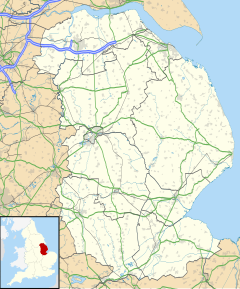This article needs additional citations for verification. (February 2011) |
Tealby is a village and civil parish in the West Lindsey district of Lincolnshire, England, situated on the edge of the Lincolnshire Wolds and 3 miles (5 km) north-east of Market Rasen. The population of the civil parish at the 2011 census was 593.[1]
| Tealby | |
|---|---|
 All Saints' church, Tealby | |
Location within Lincolnshire | |
| Population | 593 (20`11) |
| OS grid reference | TF155907 |
| • London | 130 mi (210 km) S |
| Civil parish |
|
| District | |
| Shire county | |
| Region | |
| Country | England |
| Sovereign state | United Kingdom |
| Post town | Market Rasen |
| Postcode district | LN8 |
| Dialling code | 01673 |
| Police | Lincolnshire |
| Fire | Lincolnshire |
| Ambulance | East Midlands |
| UK Parliament | |
Community
editTealby is noted for the Tennyson d'Eyncourt family, which provided the village hall and school.[citation needed] In the 1980s the school was used for filming the programme Nanny.[citation needed]
In the early 2000s the village was granted permission for a shop to be built, now run by volunteers.[citation needed] The village post office was threatened with closure but it is open at certain times of the week.[citation needed] Tealby church, built using local orange-iron stone, is dedicated to All Saints and dates back to the 12th century; it holds memorials to the Tennyson d'Eyncourt family.[citation needed] Tealby residents included Bernie Taupin, who lived on Beck Hill (Elton John recorded a song about "Tealby Abbey" on Regimental Sgt Zippo).
The King's Head, one of two public houses in the village, is one of the oldest in the country and retains a thatched roof.[citation needed]
Tealby has a Bowls Club and a Lawn Tennis Club, the courts of which are a facility for the wider district, the club promoting a Young Leaders Tennis Course and competitions. The village hall, run by a committee, is used for parties, social events, playgroups, school events and meetings.[citation needed]
Bayons Manor
editTealby's Bayons Manor was once owned by Charles Tennyson, later Tennyson d'Eyncourt, the uncle of Alfred, Lord Tennyson. The estate was purchased in 1944 by a local farmer, primarily for the farmland since the house was already derelict and becoming dangerous. Because of its dangerous condition a subsequent owner had it demolished in 1964. Bayons Manor was a rare example of a Victorian stately home in the style of a moated castle.[2][3][4]
Tealby Hoard
editIn 1807 a ploughman working for George Tennyson uncovered an earthenware pot containing a hoard of some 6000 silver coins. These were examined by Sir Joseph Banks, 604 retained for collectors and reference and 5127 melted down at the Tower Mint. The Tealby pennies have been historically important in numismatics, showing development of Medieval coinage in England.[5]
Etymology
editFor a long time the placename Tealby has been attributed to Anglo-Saxon tæfl/tefl "gaming-board", here for a square piece of land, plus Old Norse -bȳ "dwelling". But there are old spellings Tavelesbi, Tauelesbi and Teflesbi, and the Anglo-Saxon word tæfl is feminine and so its genitive would be tæfle, and therefore Caitlin Green suggests that the name refers to some Taifali (a horse-riding Germanic or Sarmatian people) who invaded Gaul or were brought into Gaul by Romans as mercenaries and later crossed to Britain with the Anglo-Saxons.[6]
References
edit- ^ "Civi Parish population 2011". Neighbourhood Statistics. Office for National Statistics. Retrieved 1 June 2016.
- ^ "The Dragon and the Pearl", tealbyvillage.com. Retrieved 6 August 2010
- ^ "Bayons Manor" Archived 6 May 2011 at the Wayback Machine, drakesfamily2.webspace.virginmedia.com. 6 August 2010
- ^ "Bayons Manor" Archived 30 September 2011 at the Wayback Machine, Lost Country Houses. Retrieved 17 August 2011
- ^ Dawson, A. An Introduction to the Tealby Issue of Henry II Coins and Antiquities magazine August 1999 pp36-9
- ^ http://www.arthuriana.co.uk/papers/TealbyGreenProof.pdf Lincolnshire History and Archaeology Vol. 46, 2011
External links
edit- Media related to Tealby at Wikimedia Commons
- Tealby Watermill
- www.thisistealby.com
